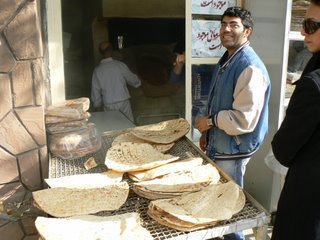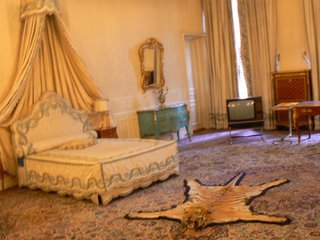Tehran’s Saad Abad and the Crown Jewels
Tehran has a population estimated at between 8 and 12 million, and sprawls out from the north, butted up against Damovan mountain with lots of snow and a cablecar to the top, spreading and growing every year far, far out.
I was told that North Tehran, where the shah once lived, is the richest area, and as you get lower and lower it gets poorer and poorer. The air too, gets worse down in South Tehran, and the traffic inches along except for the motorcycles who zip between sometimes against traffic.
We visited the Saad Abad, the complex that once was where the shah and his many relations lived in 18 buildings and palaces before the revolution in 1979 that began with Ayatollah Khomeini’s triumphant return from France. Sycamore trees line the grounds, providing a leafy canopy and a river runs down the sloped area. It surprised me that so much of this wasn’t destroyed by the angry revolutionaries, but intact is the princess p hone used by the princesses and the shah’s desk and even a billiard room to entertain the many people who used to wait to meet with the King.
hone used by the princesses and the shah’s desk and even a billiard room to entertain the many people who used to wait to meet with the King.
 hone used by the princesses and the shah’s desk and even a billiard room to entertain the many people who used to wait to meet with the King.
hone used by the princesses and the shah’s desk and even a billiard room to entertain the many people who used to wait to meet with the King.We then set out through the crowded streets to a neighborhood of winding streets, cafes bakeries, kabob stands and vegetable sellers called Darakeh. Here we watched bakers knead dough and then throw it against the wall of a roaring fire inside a clay oven, bake it for a minute or so, then fish it out with a stick and toss it out for sale. The loaves were quickly picked up by passing customers, each one cost about 70 cents.
The Crown Jewels are another big attraction here in Tehran. We had to clear our pockets of cameras cellphones and anything else, before entering a vault to view the most spectacular collection of bejewelled crowns, a throne, a bed, a globe and various jewelry. The crown that Farah Shah used to wear alone had a thousand diamonds and emeralds as big as acorns. An alarm frequently sounded when the throngs of black-clad schoolgirls would push too close to the gem cases.
After the National Museum, where we saw some of the best carvings from Persepolis we visited a former army barracks that is now an arts center, complete with vegetarian cafe and exhibits from local artists. After a fill up on felafel, we were fortified for an hour-long session in traffic making our way back up to the north to our hotel.

